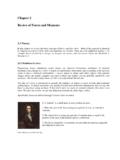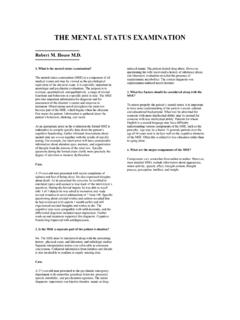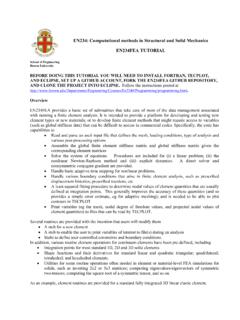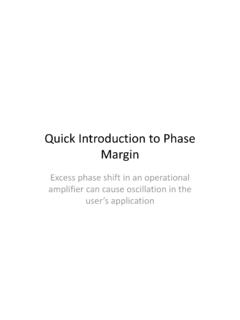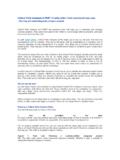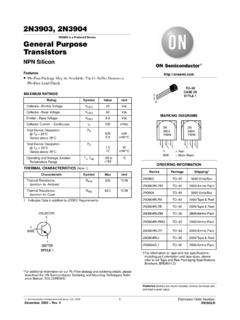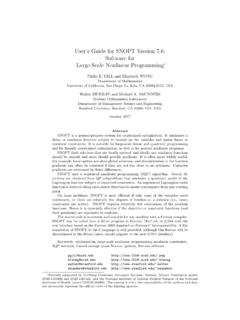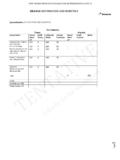Transcription of 1.1.22 UEL User subroutine to define an element. …
1 UELUser subroutine to define an : abaqus /Standard Warning: This feature is intended for advanced users only. Its use in all but the simplest testexamples will require considerable coding by the user/developer. User-defined elements , Section of the abaqus Analysis User's Manual, should be read before s User-defined elements , Section of the abaqus Analysis User's Manual*UEL PROPERTY*USER ELEMENTO verviewUser subroutine UEL:will be called for each element that is of a general user-defined element type ( , not defined by a linearstiffness or mass matrix read either directly or from results file data) each time element calculations arerequired.
2 And(or subroutines called by user subroutine UEL) must perform all of the calculations for the element,appropriate to the current activity in the kinematic dataFor abaqus /Aqua applications four utility routines GETWAVE, GETWAVEVEL, GETWINDVEL, andGETCURRVEL are provided to access the fluid kinematic data. These routines are used from within usersubroutine UEL and are discussed in detail in Obtaining wave kinematic data in an abaqus /Aqua analysis, Section r subroutine inte rface subroutine UEL(RHS,AMATRX,SVARS,ENERGY,NDOFEL,NRHS, NSVARS, 1 PROPS,NPROPS,COORDS,MCRD,NNODE,U,DU,V,A, JTYPE,TIME,DTIME, 2 KSTEP,KINC,JELEM,PARAMS,NDLOAD,JDLTYP,AD LMAG,PREDEF,NPREDF, 3 LFLAGS,MLVARX,DDLMAG,MDLOAD,PNEWDT,JPROP S,NJPROP,PERIOD)C INCLUDE ' 'C DIMENSION RHS(MLVARX,*),AMATRX(NDOFEL,NDOFEL),PROP S(*), 1 SVARS(*),ENERGY(8)
3 ,COORDS(MCRD,NNODE),U(NDOFEL), 2 DU(MLVARX,*),V(NDOFEL),A(NDOFEL),TIME(2) ,PARAMS(*), 3 JDLTYP(MDLOAD,*),ADLMAG(MDLOAD,*),DDLMAG (MDLOAD,*), 4 PREDEF(2,NPREDF,NNODE),LFLAGS(*),JPROPS( *) user coding to define RHS, AMATRX, SVARS, ENERGY, and PNEWDT RETURN ENDV ariables to be definedThese arrays depend on the value of the LFLAGS array containing the contributions of this element to the right-hand-side vectors of the overall system ofequations. For most nonlinear analysis procedures, NRHS=1 and RHS should contain the residual exception is the modified Riks static procedure ( Static stress analysis, Section of the AbaqusAnalysis User's Manual), for which NRHS=2 and the first column in RHS should contain the residual vectorand the second column should contain the increments of external load on the element.
4 RHS(K1,K2) isthe entry for the K1th degree of freedom of the element in the K2th right-hand-side array containing the contribution of this element to the Jacobian (stiffness) or other matrix of theoverall system of equations. The particular matrix required at any time depends on the entries in theLFLAGS array (see below).All nonzero entries in AMATRX should be defined, even if the matrix is symmetric. If you do not specifythat the matrix is unsymmetric when you define the user element, abaqus /Standard will use the symmetricmatrix defined by , where is the matrix defined as AMATRX in this subroutine .
5 If youspecify that the matrix is unsymmetric when you define the user element, abaqus /Standard will useAMATRX array containing the values of the solution-dependent state variables associated with this element. Thenumber of such variables is NSVARS (see below). You define the meaning of these general nonlinear steps this array is passed into UEL containing the values of these variables at thestart of the current increment. They should be updated to be the values at the end of the increment, unlessthe procedure during which UEL is being called does not require such an update.
6 This depends on theentries in the LFLAGS array (see below). For linear perturbation steps this array is passed into UELcontaining the values of these variables in the base state. They should be returned containing perturbationvalues if you wish to output such KINC is equal to zero, the call to UEL is made for zero increment output (see Output, of the abaqus Analysis User's Manual). In this case the values returned will be used only for outputpurposes and are not updated general nonlinear steps array ENERGY contains the values of the energy quantities associated with theelement.
7 The values in this array when UEL is called are the element energy quantities at the start of thecurrent increment. They should be updated to the values at the end of the current increment. For linearperturbation steps the array is passed into UEL containing the energy in the base state. They should bereturned containing perturbation values if you wish to output such quantities. The entries in the array areas follows:ENERGY(1)Kinetic (2)Elastic strain (3)Creep (4)Plastic (5)Viscous (6) Artificial strain energy associated with such effects as artificial stiffness introduced tocontrol hourglassing or other singular modes in the (7)Electrostatic (8)Incremental work done by loads applied within the user KINC is equal to zero, the call to UEL is made for zero increment output (see Output, of the abaqus Analysis User's Manual).
8 In this case the energy values returned will be used only foroutput purposes and are not updated that can be updatedPNEWDTR atio of suggested new time increment to the time increment currently being used (DTIME, see below).This variable allows you to provide input to the automatic time incrementation algorithms inAbaqus/Standard (if automatic time incrementation is chosen). It is useful only during equilibriumiterations with the normal time incrementation, as indicated by LFLAGS(3)=1. During a severediscontinuity iteration (such as contact changes), PNEWDT is ignored unless CONVERT SDI=YES isspecified for this step.
9 The usage of PNEWDT is discussed is set to a large value before each call to PNEWDT is redefined to be less than , abaqus /Standard must abandon the time increment and attemptit again with a smaller time increment. The suggested new time increment provided to the automatic timeintegration algorithms is PNEWDT DTIME, where the PNEWDT used is the minimum value for all calls touser subroutines that allow redefinition of PNEWDT for this PNEWDT is given a value that is greater than for all calls to user subroutines for this iteration and theincrement converges in this iteration, abaqus /Standard may increase the time increment.
10 The suggestednew time increment provided to the automatic time integration algorithms is PNEWDT DTIME, where thePNEWDT used is the minimum value for all calls to user subroutines for this automatic time incrementation is not selected in the analysis procedure, values of PNEWDT that aregreater than will be ignored and values of PNEWDT that are less than will cause the job s passe d in for informationArrays:PROPSA floating point array containing the NPROPS real property values defined for use with this is the user-specified number of real property values.
